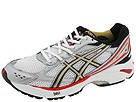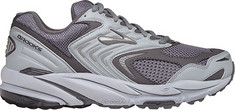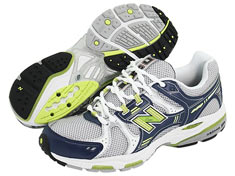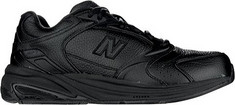Shoes
Athletic
Whether walking or running, the right amount of support and cushioning goes a long way. Most high quality shoes utilize different densities of foam to support the foot through the gait cycle. Rigid but comfortable heel counters and torsional stability make these supportive recommendations the best for your athletic activity.
The athletic shoe industry in the last three decades has made great strides in the understanding of shoe construction as it relates to injury prevention. Nike’s introduction of “air” placed air pockets in strategic locations in the midsole of their athletic shoes was in an effort to increase the cushioning characteristics of their shoes. The goal of this increase cushioning was to decrease stress related injuries in athletes including stress fractures. “Nike air” revolutionized the modern day athletic shoe and its success spurred many other athletic shoe manufacturers to focus on cushioning systems in their shoes.
Ethyl Vinyl Acetate (EVA) is a closed cell foam material that provides most of the cushioning in today’s running and athletic. This foam material has a limited life span and provides most of its protective cushioning over a short period of time. As a general rule walkers and runners are recommended to replace their shoes after 300-500 miles of use due to the EVA losing its cushioning properties.
Shoe manufactures in developing an athletic shoe attempt to find balance between the cosmetic design elements that help the shoe sell and the research and development that focus on the features of the shoe that help with injury prevention. In shoe design the midsole section of the shoe is probably the most important aspect of the shoe that will aid in injury prevention.
The two general types of injury patterns seen in the lower extremity are stress related and motion related:
Stress related injuries include stress fractures involving the bony structure of the lower extremity. Stress fractures are clearly influenced by the cushioning systems that are placed into the shoes and are certainly related to training techniques as well as surfaces that are run on.
Motion related injuries relate to the inherited motion of the foot called supination and pronation. Oversimplified, supination refers to the high arch foot and pronation refers to the low arch or flat foot. Both of these are motions that occur in the foot during normal walking and running. Pronation is the motion that allows the foot to adapt to different foot plant surfaces and tends in excess to put the foot at greater risk for injury including many forms of tendonitis, joint pain and heel pain most commonly termed plantar fascitis.
The dilemma that shoe manufactures are faced with in the development of a shoe is that increased shoe cushioning facilitates an increase in motion of the foot. An excessively cushioned shoe may be good for preventing stress injuries but may not provide enough support to control the pronation of the foot. Finding the correct amount of cushioning and support is the ultimate goal in this process.
The athletic shoe culturally has superseded any other shoe in its frequency of use. Much to the liking of the athletic shoe manufacturers athletic shoes are being used in mainstream day to day activities as well as sport. The typical person wearing these shoes daily doesn’t appreciate the limited life span that a shoe should be worn for. Most people feel that if a shoe looks in good condition cosmetically that it is still alright to wear. Clearly the midsole materials of these shoes will wear excessively before the shoe looks cosmetically worn.
The athletic shoe industry has had such a profound impact on shoe manufacturing techniques that the non athletic shoe manufactures have adopted many of the similar manufacturing techniques as well as materials used. The push for cushioning in shoes clearly makes shoes a part of the wardrobe that must be replaced with increasing frequency. For example a dress casual style shoe with a leather outsole will last much longer than one that is fabricated from foam. There is a continued perception that dress casual shoes will last a long time without need for replacement.
Increased incidence of foot pain may be related to many variables including an aging population. One is left to wonder however what influence excessive cushioning or excessive wear on the development of foot pain as it relates to abnormal foot pronation. If your foot pronates excessively and you wear a shoe with excessive cushioning your foot will leverage off this soft foam material and pronate even more thus increasing your risk for pronation related injury.
The basic understanding that support and cushioning are two key components in shoe construction that can have an influence in the development as well as recovery from injury are important when selecting a shoe. Having your physician recommend a specialty retail shoe store that is comfortable with providing expertise in shoe selection and fit is critical when purchasing shoes. Although you may pay more for a shoe at a specialty retail shoe store the ability to make the correct purchase for you and your specific foot condition will expedite your recovery and the return to all of the activities that you are missing.
-
 ASICS - Kayano 16 - Men'sRead More »
ASICS - Kayano 16 - Men'sRead More »This is the 'Cadillac' of stability shoes from ASICS. Maximum cushioning with gel in the forefoot and heel. Typically a similar fit to the ASICS Gel-2000 series, but lower profile …
-
 ASICS - Foundation 8 - Men'sRead More »
ASICS - Foundation 8 - Men'sRead More »A good, stable shoe from ASICS. Not quite as much cushion or support compared to the ASICS Evolution. Lower price than typical maximum support Motion Control shoes. A great fit with most orthotics, this shoe is good for runners and walkers with a medium to heavier build and/or …
-
 ASICS - Evolution 5 - Men'sRead More »
ASICS - Evolution 5 - Men'sRead More »The most stable and highest degree of motion control from the ASICS line. A great fit with most orthotics, this shoe is good for runners and walkers with a heavier build and/or pounding heel-strike. Biomorphic Fit ® Upper offers good flexibility and comfortable …
-
 ASICS - 2150 - Men'sRead More »
ASICS - 2150 - Men'sRead More »The industry's most popular running shoe makes a return in the form of the GT-2150™, an offering from ASICS™ that will meet and exceed the expectations of million of runners world wide.
Running shoe built for the neutral to moderate over-pronator who requires a combination of …
-
 Adidas - Supernova Sequence 2 - Men'sRead More »
Adidas - Supernova Sequence 2 - Men'sRead More »A great selection for the Moderate pronator. This stability shoe supports the narrower athlete's foot and typically fits a medium to high arch. Narrowness of the heel is a mainstay among Adidas. Lots of soft cushioning undefoot feels like your feet ride on top of all those layers.
-
 Adidas - AdiSTAR Salvation - Men'sRead More »
Adidas - AdiSTAR Salvation - Men'sRead More »Softly cushioned Maximum Stability shoe. Most Adidas shoes typically fit a more narrow foot, usually with a high arch. If you have a narrow heel or thin foot, try an Adidas.
-
 Adidas - AdiZERO Tempo - Men'sRead More »
Adidas - AdiZERO Tempo - Men'sRead More »Suitable for the Mild-overpronator, this Adidas selection could be the perfect fit with that touch of Stability. Cushioning where you need it and support through slight medial posting offer a smooth ride for the typical smaller framed runner. Adidas also fits more narrow to the heel …
-
 Adidas - Supernova Glide 2 - Men'sRead More »
Adidas - Supernova Glide 2 - Men'sRead More »Soft ride in a compact uppper. This Neutral selection offers a lot fo cushioning and nothing else you don't need. Adidas shoes typically fit more sug in the heel and have a narrower waist.
-
 Brooks - Adrenaline GTS 10 - Men'sRead More »
Brooks - Adrenaline GTS 10 - Men'sRead More »The Brooks Adrenaline is a great go-to stability shoe. Comparable to the ASICS Gel-2000 series. Typically works well with orthotics. This iteration may be better as a true running shoe (compared to years past) because of its increased heel bevel. The perfect blend of …
-
 Brooks - "Beast"Read More »
Brooks - "Beast"Read More »From their site: To us it’s the Beast®. But to the ever-increasing and exceptionally loyal runners who swear by it, it’s called salvation. In updating …
-
 New Balance - MR850Read More »
New Balance - MR850Read More »From their catalog: Running Shoes are the heart and soul of what New Balance does. Each running shoe provides the stability, cushioning, and performance to give serious runners an edge—and give runners amazing comfort.
STABILITY … -
 New Balance Men's Running MR1123Read More »
New Balance Men's Running MR1123Read More »New Balance Men's running shoe. Hard-to-find lateral support!
A high mileage trainer for the runner who requires maximum motion control, stability and cushioning. It features ABZORB FL, ABZORB SBS Heel and forefoot, NLOCK, ROLLBAR GR, multi-density insert, 360 degree …
-
 New Balance - MW927Read More »
New Balance - MW927Read More »From their catalog: The industry’s leading motion control walking shoe for walkers who require minimal flex and superior comfort …
-
 Nike - Structure Triax 13 - Men'sRead More »
Nike - Structure Triax 13 - Men'sRead More »Designed with the Mild to Moderate Overpronator in mind. **WATER RESISTANT MODEL** Great Stability shoe for the runner that heel strikes. The Nike brand typically fits a more narrow foot. Compare this shoe to Adidas Supernova Sequence. Also available in a standard mesh …
-
 Nike - Equalon 4 - Men'sRead More »
Nike - Equalon 4 - Men'sRead More »The Nike Equalon is designed for Moderate to Severe Over-Pronators. This shoe has plenty of support and good cushioning for those runners with a heavy heel strike. Runners with more of a narrow foot should find a good fit from both Nike and Adidas.